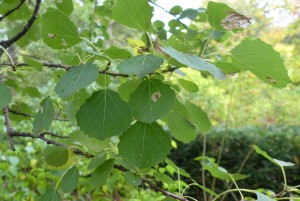Aspen – Populus tremula (Salicaceae)
Gaelic: critheann
Common Names: Quaking Aspen
The aspen is native throughout the cool and temperate regions of Europe and Asia, and has the most northerly distribution of those trees native to Scotland, occurring in Shetland out of the way of grazing animals. It can grow to around 20m in height and produces suckers, meaning it is often found in stands of several trees, all clones of the original. Aspen flowers are catkins, with male and female occurring on different trees (dioecious), and are wind pollinated. The leaves differ between seedlings and young trees, which are ovate (more or less heart shaped) and more mature trees where the leaves are rounder, with a wavy edge. The stem of the leaf (petiole) is flattened, which causes them to tremble in even the slightest breeze. This is reflected in the latin name ‘tremula’, common name ‘Quaking Aspen’ and it’s gaelic name ‘critheann’ which means ‘quivering one’.
It has been largely despised for the poor quality of its timber, with few things being made from it, like matches and basic crates. The leaves and bark can be used to make green and black dyes.
It was believed that the aspen quaked and trembled as it was cursed by the devil, or was the tree the cross of Jesus was made from.
Location


1 Comment
1 Pingback